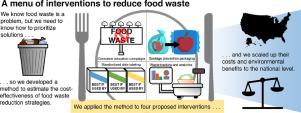Resources, Conservation and Recycling ( IF 11.2 ) Pub Date : 2021-02-02 , DOI: 10.1016/j.resconrec.2021.105448 Quentin D. Read , Mary K. Muth

|
At least 30% of food is wasted during the journey from farm to processor to retailer to consumer in the United States, accounting for an estimated 20% of the environmental impact of the food system. The food waste problem is well characterized, but solutions are not: there has been little rigorous comparison of the costs and potential benefits of food waste reduction interventions. Food waste reduction is often described as a “win–win,” benefiting consumers, the environment, and businesses’ bottom line. We present a method for evaluating this claim by accounting for the costs and environmental benefits of food waste reduction. The procedure involves assembling data on costs and efficacy of the intervention, scaling the costs up to the national level, estimating the quantity and value of food waste averted, and finally estimating the potential averted environmental impact. We apply our method to four representative nationwide interventions: consumer education and public awareness campaigns, spoilage prevention packaging for produce and meat, standardization of date labels, and foodservice waste tracking systems. The estimated annual cost of each intervention varied from $126 to $595 million. The environmental cost-effectiveness of the interventions varied two- to threefold (for example, 6 to 16 kg CO2 reduced per $1 invested). Outstanding questions include how to scale interventions to the national level and how to address the mismatch between who incurs the costs of implementation and who benefits. Our method can be adapted to waste interventions across the food system and in countries beyond the United States.
中文翻译:

四种厨余干预措施的成本效益:减少厨余是“双赢”吗?
在美国,从农场到加工者再到零售商再到消费者的过程中,至少有30%的食物被浪费掉,估计占食物系统对环境的20%。餐厨垃圾的特征已得到很好的描述,但解决方案却没有:减少餐厨垃圾的成本和潜在收益之间没有严格的比较。减少食物垃圾通常被描述为“双赢”,使消费者,环境和企业的底线受益。我们提出一种方法,通过考虑减少食物浪费的成本和环境效益来评估此主张。该程序涉及收集有关干预措施的成本和功效的数据,将成本扩大到国家一级,估算避免的食物垃圾的数量和价值,并最终估算避免的潜在环境影响。我们将我们的方法应用于全国四个有代表性的干预措施:消费者教育和公众意识运动,农产品和肉类的防腐败包装,日期标签的标准化以及餐饮废物追踪系统。每次干预的估计年度费用从126美元到5.95亿美元不等。干预措施的环境成本效益是两倍至三倍(例如6至16千克二氧化碳每投资1美元减少2个)。悬而未决的问题包括如何将干预措施扩大到国家一级,以及如何解决谁招致实施成本和谁受益之间的不匹配。我们的方法可以适用于整个食品系统以及美国以外的国家的废物干预措施。











































 京公网安备 11010802027423号
京公网安备 11010802027423号